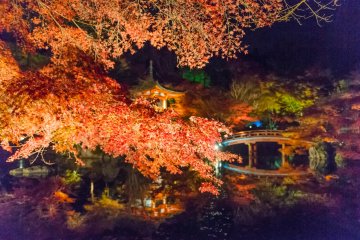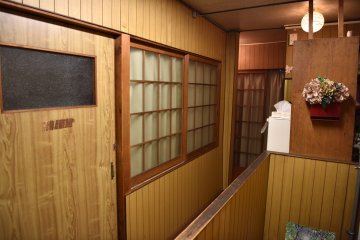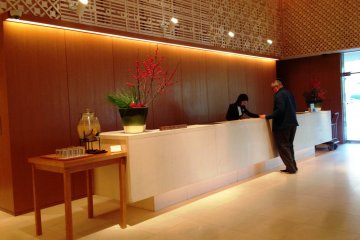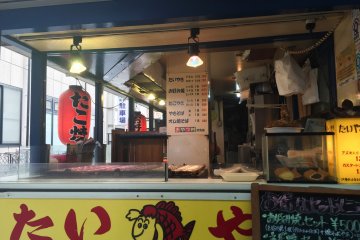

Founded in 874, Daigo-ji Temple is one of Kyoto's most scenic religious sites. The hillside temple grounds make it a prime spot for cherry blossom and fall foliage, and its traditional buildings add to the rustic charm of the landscape. The main temple grounds are located is at the foot of the mountain and is connected to several other temple buildings around the summit via a hiking trail.
The Daigo-ji also plays an important role in the Shingon sect of Japanese Buddhism. Its main buildings are home to dozens of valuable cultural artifacts, which has resulted in the Daigo-ji Temple being named a World Heritage Site by UNESCO. The main area of the temple is home to the Reihokan Museum, which preserves and exhibits the temple's vast collection of historical documents and art objects, including statues and paintings.
Sanboin Temple is perhaps most well-known for being the building that Toyotomi Hideyoshi helped reconstruct back in 1598. It was the main building on the temple grounds, used to host the feudal archbishops back in the past. Sanboin’s exquisite Japanese garden is a prime example of Momoyama-period architecture. The building itself also hosts multiple National Treasures and Important Cultural Assets.
Constructed in the year 951, Goju-no-to is one of Kyoto’s oldest national treasures. The pagoda is also revered for being the oldest building that remained after the Onin War in the 1400s. It was originally built by Emperor Suzaku, the oldest son of Emperor Daigo, to serve as a resting place for Emperor Daigo’s soul.
Daigo-ji is one of the best places in Kyoto to view the cherry blossoms, much like how Toyotomi Hideyoshi did back in the 16th century. Approximately 1,000 cherry blossom trees were planted across the temple grounds, with the most impressive being the weeping cherry tree standing outside the Reihokan Museum. It was said that Toyotomi Hideyoshi planted 700 of these trees in order to host his famous hanami party and procession, in which a similar event is now held annually to commemorate and honor his contributions.
10-minute walk from Daigo Station on the Tozai Subway Line
Keihan Express Bus to “Daigo -ji” bus stop(from JR Kyoto Station, Hachijoguchi Bus Stop) or to “Daigo -ji mae” bus stop (from JR Yamashina Station and Rokujizo Station on the Keihan Railway)


Red and yellow leaves enhance the beauty of World Heritage Site Daigoji, which has has the oldest pagoda in Kyoto, and many other beautiful buildings.

Daigoji (醍醐寺) is a Buddhist temple found in an attractive forest setting in the ancient capital of Kyoto. An exquisite traditional garden, and numerous beautiful halls and treasures, await.

World Heritage temple Daigoji in Kyoto has a reputation for beautiful cherry blossoms in spring, and there are many cherry trees growing in the temple grounds.

Daigo-ji Temple is one of the famous spots for cherry blossom viewing in Kyoto, but also has a reputation for beautiful autumn leaves. When Toyotomi Hideyoshi ruled Japan, he hosted a grand cherry blossom viewing party here, but he died before leaves turned color in autumn

Along the trail of Kami-Daigo in Kyoto are several World Heritage buildings and at the top is famous Nyoirindo, built in the Momoyama period (1573-1603)

Ladies Inn Guesthouse Usagi-Momiji: by far the best accommodation I have ever found in Kyoto

The trees and the gardens in Kyoto have been there for hundreds of years. When I am looking at the burrowed view of the mountains and contemplating life or just breathing in the moment, I become part of the practice that the philosophers and scholars have done since the Tale of Genji

This is the place where Ryoma Sakamoto was attacked by authorities. His wife Oryo saved him by running naked from the bath to inform him of the coming danger!

Visiting the Kansai region and wanting to try one of the signature dishes of Western Japan, “Okonomiyaki?” Or, have you already tried and loved the dish in Hiroshima, but are craving the delicate flavor of bonito flakes, grilled cabbage, soft and tender pork strips, and maybe even grilled octopus if you’re feeling for the flavor adventure? Look no further than NoBoRi (のぼり in Fushimi, Kyoto.

Torikizoku is a popular and affordable yakitori chain store in Japan. What is yakitori? Yakitori is grilled chicken served on wooden skewers in a variety of flavors - teriyaki, spiced salt, spicy, and more. Torikizoku serves extremely tender “Momo Yakitori,” which is the signature chicken meat skewer of many yakitori restaurants, and is a favorite for fans from around the world.

The popular Japanese cakes shaped like small fish are called "taiyaki" which translates directly to "baked seam bream. At this small but extremely popular and busy stall named Oyatsumura in Otesuji, a shopping plaza situated in Fushimi, Kyoto, you will be able to enjoy this tasty Japanese snack. Taiyaki at this store comes in two classic Japanese flavors - a creamy custard and an azuki-bean filling.

Ōbaku-san Manpuku-ji is a temple located in Uji, Kyoto. It is the head temple of the Japanese Ōbaku Zen sect, named after Wanfu Temple in Fujian, China. The mountain is likewise named after Mount Huangbo, where the Chinese temple is situated. [Wikipedia]

Fushimi Inari, officially known as Fushimi Inari Taisha, is a beautiful Shinto shrine in southern Kyoto, famous for its thousands of vermilion torii. The torii gates along the way are donations from individuals and companies and on the back of each gate is the name of the donor and the date of the donation. The trails lead into the wooded forest of the sacred mountain Inari, which is 233 meters high and is part of the shrine grounds. The hike to the top of the mountain and the way back take about 2-3 hours. The shrine is dedicated to Inari, the Shinto god of rice. Since it is believed that foxes are Inari's messengers, there are numerous fox statues throughout the shrine grounds. The Fushimi Inari Shrine is the main shrine of all 30,000 Inari shrines in Japan.

Tofukuji temple (東福寺), particularly known for its autumn leaves, was founded in 1236 and is the head temple of the Tofukuji School of the Rinzai sect of Zen Buddhism.